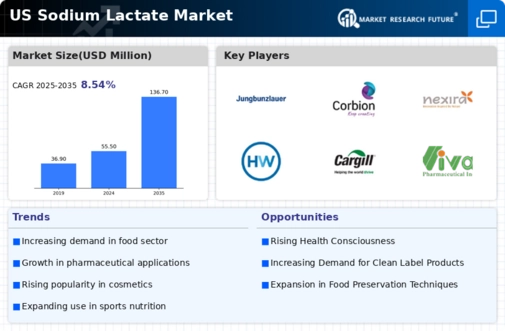The sodium lactate market exhibits a dynamic competitive landscape characterized by a blend of innovation, strategic partnerships, and regional expansion. Key players such as Cargill (US), BASF (DE), and Corbion (NL) are actively shaping the market through their distinct operational focuses. Cargill (US) emphasizes sustainability and product innovation, aiming to enhance its portfolio with bio-based solutions. BASF (DE) leverages its extensive research capabilities to develop high-performance products, while Corbion (NL) focuses on expanding its production capacity to meet rising demand in food and pharmaceutical applications. Collectively, these strategies foster a competitive environment that prioritizes innovation and sustainability, driving growth in the sodium lactate sector.
In terms of business tactics, companies are increasingly localizing manufacturing to reduce lead times and optimize supply chains. This approach not only enhances operational efficiency but also aligns with the growing consumer demand for locally sourced products. The market structure appears moderately fragmented, with several key players exerting influence over pricing and product offerings. The collective actions of these companies suggest a trend towards consolidation, as firms seek to enhance their market positions through strategic collaborations and acquisitions.
In October 2025, Cargill (US) announced a partnership with a leading biotechnology firm to develop a new line of sodium lactate products derived from renewable resources. This strategic move underscores Cargill's commitment to sustainability and positions the company to capitalize on the increasing consumer preference for eco-friendly products. By integrating biotechnology into its production processes, Cargill (US) aims to enhance its competitive edge in the market.
In September 2025, BASF (DE) unveiled a new production facility in the Midwest, aimed at increasing its sodium lactate output by 30%. This expansion reflects BASF's strategy to meet the growing demand in the food and beverage sector while also reducing transportation costs. The facility is expected to enhance the company's supply chain efficiency and strengthen its market presence in North America.
In August 2025, Corbion (NL) launched a new marketing campaign highlighting the versatility of sodium lactate in various applications, including food preservation and personal care products. This initiative not only aims to educate consumers about the benefits of sodium lactate but also positions Corbion (NL) as a thought leader in the industry. The campaign is likely to enhance brand recognition and drive sales across multiple sectors.
As of November 2025, the sodium lactate market is increasingly influenced by trends such as digitalization, sustainability, and the integration of artificial intelligence in production processes. Strategic alliances are becoming more prevalent, as companies recognize the value of collaboration in driving innovation and enhancing supply chain reliability. Looking ahead, competitive differentiation is expected to evolve, shifting from price-based competition to a focus on technological advancements and sustainable practices. This transition may redefine market dynamics, compelling companies to innovate continuously to maintain their competitive positions.

















Leave a Comment